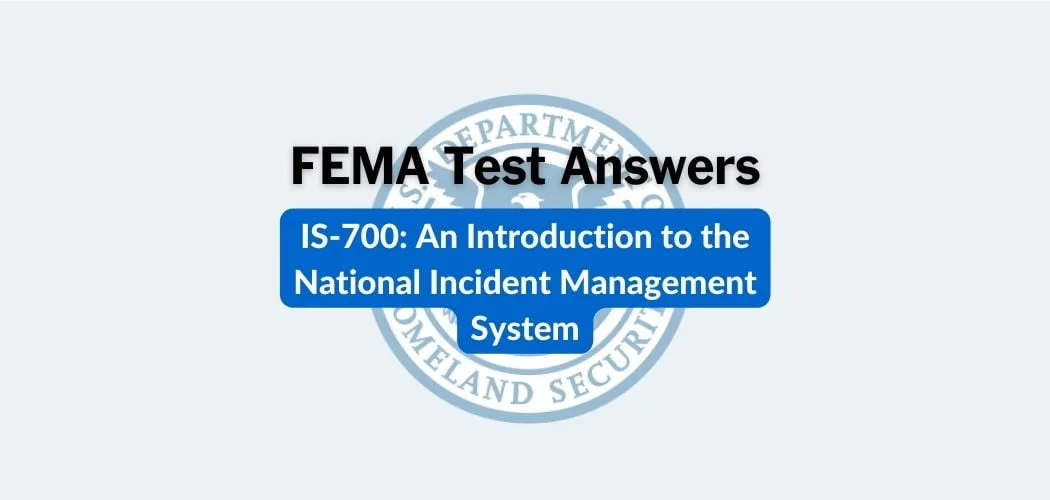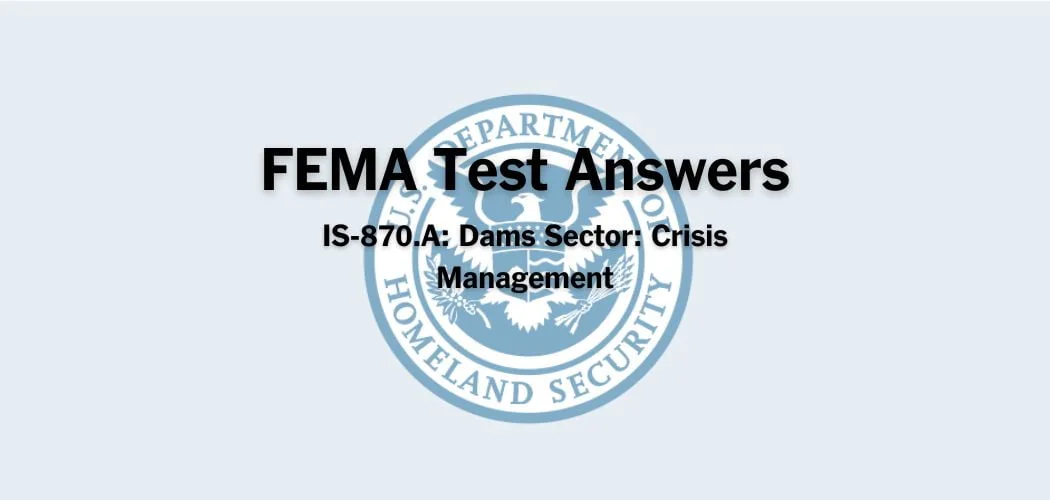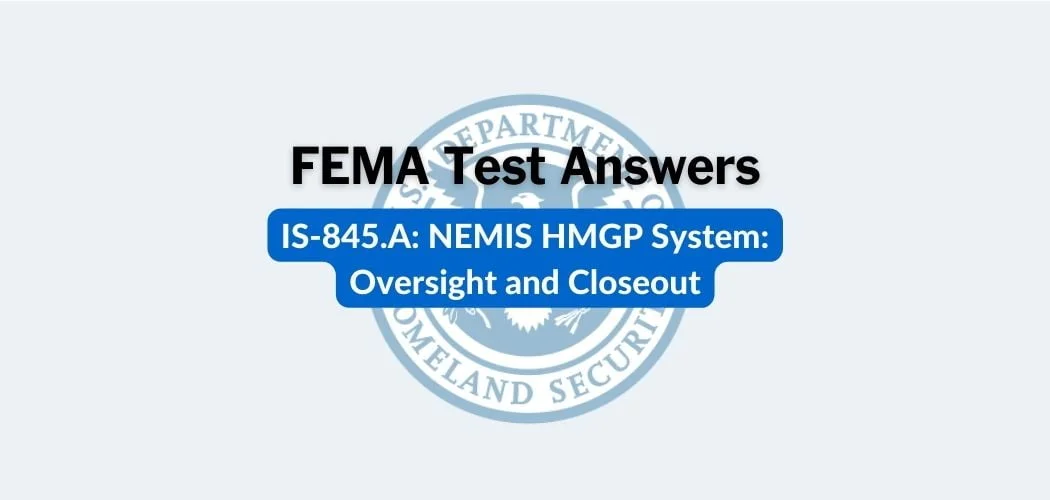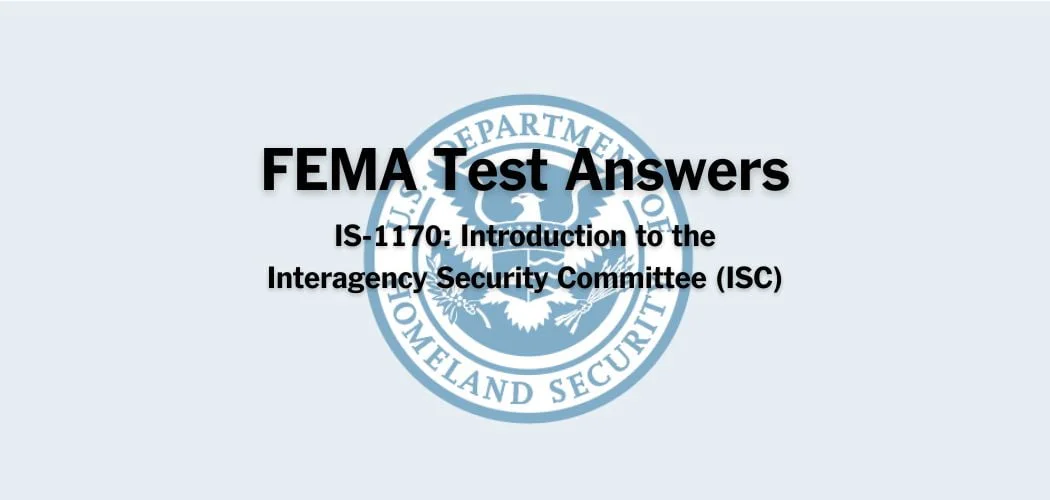Overview: FEMA IS-5.A course was published on 10/31/2013 to provide a general introduction to hazardous materials that can serve as a foundation for more specific studies in the future.
FEMA IS-5.A does not meet the Hazardous Materials response requirements identified in the HAZWOPER standard (29CFR1910.120(q)(6)(i)). This course has five units and no prior knowledge of the subject is required or assumed.
FEMA IS-5.A test answers
Each time this test is loaded, you will receive a unique set of questions and answers. The test questions are scrambled to protect the integrity of the exam.
Question 1. The success of good site operations and the ability of employees to respond during emergencies is:
A. Well-rehearsed response team
B. Annual inspections of the site
C. Good site planning
D. Initial and annual refresher training✅
Question 2. A toxic accident occurs in your neighborhood. Several adults, teenagers, and small children are present. Which group, if any, would likely be most severely affected?
A. The small children would be most severely affected✅
B. The adults would be most severely affected
C. The teenagers would be most severely affected
D. All would be affected to the same degree
Question 3. In-place sheltering is never an appropriate option in an accident involving hazardous materials.
A. True
B. False✅
Question 4. Existing landfills are generally considered sufficient to serve as the sole means of disposing of the Nation’s waste for the foreseeable future.
A. True
B. False✅
Question 5. Standard approaches to waste disposal are generally regulated and managed by the:
A. DOT
B. OSHA
C. FEMA
D. EPA✅
Question 6. By reading the placard on a tanker bearing hazardous materials, you can find out:
A. The amount of the substance being carried
B. The name of the carrier
C. The date the substance was shipped
D. The hazard class of the substance being carried✅
Question 7. Health affects resulting from contact with a hazardous substance over a long period of time is called:
A. Doxological exposure
B. Systemic exposure
C. Serological exposure
D. Chronic exposure✅
Question 8. Once approved, an Emergency Operations Plan should never be revised, since this would create potential confusion in responding agencies.
A. True
B. False✅
Question 9. The code OXY in the bottom white quadrant of a label conforming to NFPA 704 indicates that:
A. The material reacts with water
B. The material is radioactive
C. The material will explode on contact with air
D. The material can easily release oxygen to create or worsen a fire or explosion hazard✅
Question 10. Formal mutual aid agreements with surrounding jurisdictions are seldom if ever needed, since everyone is ready to pitch in when an incident occurs.
A. True
B. False✅
Question 11. A person works every day with a toxic substance, but does not take protective measures. The individual will experience what type of exposure?
A. Chronic✅
B. Carcinogenic
C. Lethal
D. Acute
Question 12. In the NFPA 704 labeling system, a rating of 4 in any quadrant corresponds to:
A. A moderately low hazard
B. The highest degree of hazard✅
C. A moderately high hazard
D. The lowest degree of hazard
Question 13. A Material Safety Data Sheet (MSDS) includes information on:
A. Laws governing the use of a specific chemical
B. The cost of a specific chemical
C. The amount of a specific chemical that can be legally released
D. Health effects and physical properties of a specific chemical✅
Question 14. An industry’s smokestack is an example of what type of source?
A. Area
B. Point✅
Question 15. The key components of a complete local plan include a basic plan, supporting annexes, and implementing procedures. The supporting annexes typically include:
A. Lists of people to alert under certain conditions
B. ‘How to’ instructions for operating departments or individuals
C. Information on how specific functions (such as evacuation) will be carried out for particular hazards
D. Conceptual framework for emergency operations✅
Question 16. Which of the following correctly identifies the four ‘routes of entry’ for toxic substances into the body:
A. Absorption, injection, ingestion, inhalation
B. Injection, ingestion, integration, absorption
C. Absorption, injection, insertion, inhalation✅
D. Irritation, injection, absorption, asphyxiation
Question 17. Which Federal agency provides training, resource information and technical assistance to States to help them prepare for hazardous materials emergencies?
A. The Federal Emergency Management Agency✅
B. The Environmental Protection Agency SARA Grants
C. The Department of Labor
D. The Department of Transportation HMEP Grants
Question 18. Results of Commodity Flow Surveys can be obtained from:
A. LAPD
B. SEMA
C. LEPC✅
D. FEMA
Question 19. Sensory clues to the possible presence of hazardous materials in water include:
A. Dead fish
B. Unusual algae growth
C. White froth
D. All of these✅
Question 20. A chemical that, in relatively small amounts, produces injury when it comes in contact with skin tissue is known as:
A. An explosive
B. A corrosive✅
C. A flammable liquid
D. A radioactive material
Question 21. The tendency of chemicals to become more concentrated as they move up the food chain is known as:
A. Biodegradation
B. Biomagnification✅
C. Chemical breakdown
D. Leachification
Question 22. One benefit of a sound community plan to deal with a hazardous materials emergency is:
A. Roles and responsibilities are defined✅
B. The likelihood of an incident occurring is almost eliminated
C. The need for assistance from other jurisdictions is eliminated
D. Fewer resources are required to handle the incident
Question 23. Permissible exposure limits are levels of exposure mandated by:
A. OSHA✅
B. EPA
C. ACGIH
D. USCG
Question 24. The Federal law designed to regulate hazardous waste ‘from cradle to grave’ is:
A. Toxic Substances Control Act
B. Superfund
C. Safe Drinking Water Act
D. Resource Conservation and Recovery Act of 1976✅
Question 25. Besides the LEPC, what local agencies may maintain specific information on industries in your community that use, store, or generate EHS-listed hazardous materials?
A. The local public works department
B. The local emergency services department
C. The local fire department
D. The local police
Question 26. Which Federal law is intended to assure, so far as possible, safe working conditions?
A. The Clean Air Act
B. The Safe Drinking Water Act
C. The Toxic Substances Control Act
D. The Occupational Safety and Health Act✅
Question 27. What is the primary purpose of a Hazardous Materials Response Team?
A. To inspect buildings where hazardous chemicals are used or manufactured
B. To assist in the disposal of household hazardous waste
C. To provide the skills, knowledge, and technical equipment needed to offensively handle hazardous materials incidents✅
D. To develop a community plan for responding to hazardous materials incidents
Question 28. The analysis of a situation to determine the level of risk inherent in that situation is called:
A. Risk management
B. Health effects assessment
C. Risk search
D. Risk assessment✅
Question 29. If you encounter a suspicious substance, you should:
A. Notify the appropriate authority✅
B. Immediately dispose of it yourself
Question 30. Decontamination is needed in order to:
A. Treat injuries resulting from chemical emergencies
B. Estimate the amount of contaminant to which a person has been exposed
C. Identify chemicals involved in an accident
D. Remove contaminants from people and equipment✅
Question 31. You have just learned that a chemical you work with is a mutagen. What effect does this chemical have?
A. Increases the risk of physical defects in a developing embryo
B. Irritates the lining of the throat
C. Causes a permanent change in the genetic material (DNA)✅
D. Increases the risk of cancer
Question 32. What is the recommended minimum number of personnel needed to manage a hazardous materials incident safely?
A. 5
B. 3
C. 3-5
D. 8✅
Question 33. When treating a household incident involving exposure to a poison, your most reliable source of advice and expertise is:
A. The police
B. The product’s label✅
C. The Poison Control Center
D. The local health department
Question 34. The presence of hazardous materials can always be detected by the sense of smell.
A. True
B. False✅
Question 35. The primary hazard associated with most flammable liquids is:
A. Toxic vapors
B. Fire or explosion✅
C. Faulty containers
D. Radioactivity
Question 36. It is difficult and sometimes impossible to purify contaminated groundwater.
A. True✅
B. False
Question 37. The Federal agency responsible for regulating interstate shipments of hazardous materials is:
A. Department of Transportation✅
B. Occupational Safety and Health Administration
C. Environmental Protection Agency
D. Federal Emergency Management Agency
Question 38. The local role in reducing public risks from hazardous materials includes:
A. Developing an emergency plan for hazardous materials incidents
B. Regulating hazardous materials transportation through local ordinances
C. Regulating safe disposal of hazardous waste
D. All of these✅
Question 39. The five phases of a hazardous material’s life do not include production, transportation, storage, elimination, and disposal.
A. True
B. False✅
Question 40. Under EPCRA, Local Emergency Planning Committees (LEPCs) are charged with the responsibility to:
A. Regulate hazardous materials within State borders
B. Write local ordinances to promote emergency preparedness
C. Inspect local factories to ensure compliance with Federal legislation
D. Develop an emergency plan to respond to hazardous materials incidents✅
Question 41. A person whose skin is coated with a toxic substance gives his/her contaminated clothing to another individual. This likely will result in what is called:
A. Ingestion
B. Reckless endangerment
C. Risk
D. Cross-contamination✅
Question 42. Under what circumstances are judges likely to take immediate action to halt pollution before a violation of the law has been proven in court?
A. Whenever environmental lobby groups are in agreement that the problem exists
B. In extreme cases when the potential damage is clear and irreparable✅
C. When the polluting industry is large and can afford it
D. Whenever there is cause to believe the environment might be harmed
Question 43. The EPCRA grants citizens the right to obtain information on hazardous materials in their community.
A. True✅
B. False
Question 44. The chemical agent or hazardous material that interferes with the body’s ability to transfer oxygen to the cells is:
A. Tear gas
B. Phosgene
C. Hydrogen cyanide✅
D. Nerve agent
Question 45. The basic approaches to cleaning contaminated soil include:
A. Air stripping/aeration, activated carbon, and chemical precipitation
B. Containment, off-site containment, on- or off-site treatment, or disposal✅
Question 46. If you are caught outdoors in the vicinity of a hazardous materials incident, you should try to move away from the release:
A. Downstream, downhill, and downwind
B. Close to the incident responders
C. Upstream, uphill, and upwind✅
Question 47. A primary purpose of conducting a hazardous materials exercise is to find out:
A. Whether planned procedures work✅
B. What Federal and State resources could be made available for such an incident
C. What type of incident is most likely to occur
D. Which responders should receive raises
Question 48. Under existing laws, States do not have broad authority to control how hazardous materials are stored, used, transported, and disposed of within their borders.
A. True
B. False✅
Question 49. The body has very efficient internal defenses which can remove any quantity of an unwanted substance.
A. True
B. False✅
Question 50. The Federal agency primarily responsible for protecting our environment from contamination by hazardous materials releases is:
A. The Federal Emergency Management Agency
B. The Environmental Protection Agency✅
C. The Department of Labor
D. The Department of Transportation
Other popular FEMA test answers
- IS-010: Animals in Disasters: Awareness and Preparedness
- IS-100: An Introduction to the Incident Command System (ICS)
- IS-120: An Introduction to Exercises
- IS-230: Fundamentals of Emergency Management
- IS-235: Emergency Planning
- IS-244: Developing and Managing Volunteers
- IS-363: Introduction to Emergency Management for Higher Education
- IS-700: An Introduction to the National Incident Management System
- IS-906: Workplace Security Awareness
- IS-907: Active Shooter: What You Can Do
- IS-909: Community Preparedness: Implementing Simple Activities for Everyone



